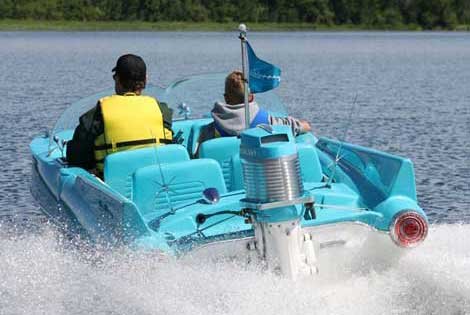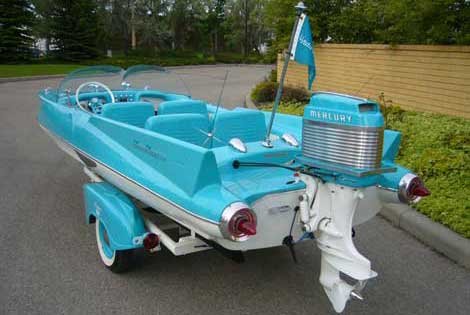Advertisement

The thing that first addicted me to boats with fins was a car. I had a '57 Chevy sedan, inherited from my grandmother as a high-school graduation present in 1980. That car was my pride and joy, or at least it was until I happened upon a 1958 Glastron Seaflite. It looked to me as if my Chevy had met its soulmate! Well, I bought the boat immediately, and began matching the colors and interior, embellishing the design a bit. I was in love!

Boat literature from the time, plus a Newsweek cover from 1957, celebrates the revolution that fiberglass brought to boatbuilding.
During this restoration, I networked with other collectors and did some research on these quirky boats. It turned out they were fairly unusual, and that rarity made the boat even more interesting to me. But I was also surprised they were so rare, given that there were literally hundreds of builders at the peak of a fad in the early 1950s, when a new material, fiberglass, was introduced to boatbuilding.

Entrepreneurs at that time quickly realized that there was very little needed to get into the boatbuilding business in terms of infrastructure. Molds could be built and the material could be "hand laid." But it was labor intensive to create a boat, and for that reason, most of the early builders lost interest in these enterprises, or failed at them. At the time there were hundreds of manufacturers, each building only a handful of boats before giving up, a happenstance that has created the perfect environment for a collectible: something that is rare enough to be desirable, but just plentiful enough to be available for enthusiasts such as yours truly. The result is a variety of stunning designs, with individual blueprints that may have seen a production of only 10 or 20 boats. One such design during this heyday was the Glass Slipper.

In 1958 Ervin Kiersey and two partners created a company in Hillsdale, Michigan, they called the Marlin Marine Division of the Thirteen Corporation. The name was no accident. They designed it to sound large and successful. In reality the Marlin Marine Division consisted of three guys making boats in a rented former school building. They named their first model made of fiberglass Glass Slipper, thinking it resembled the infamous shoe Cinderella left at the dance.
There were two Glass Slipper designs, one for 1958, the most common, and one for 1959. These were fabulous boats, with fake jet air intakes, fake jet exhausts, tail fins, headlights (two on the 1958, four on the 1959!), and numerous automotive features, including bucket seats, T-Bird style dashboards, Oldsmobile-esque front "fender" trims, and on and on.

I was delighted to make contact with Ervin through the Internet, and hear his estimate that they'd made "maybe 20 boats in total." About eight 1958s have been found, and just two 1959s. Imagine my thrill, then, when I learned that the original molds for the '59 Glass Slipper were "out beside the barn." I immediately left work and traveled 300 miles to purchase them. The molds have now been lovingly restored and used to build three more Glass Slippers, so at least one of these rare designs will be around for another few decades.
I first started looking for boats like these in 1990, and have never tired of the chase. Their unique and outrageous styling drew me into a hobby where the constant discovery of new, unheard-of designs, keeps my interest and makes me smile. You never know what's around the next corner.
Kevin "Fin" Mueller, a jeweler from Rockton, Illinois, is a collector who owns 35 boats. See more at www.boatsinthebelfry.com
